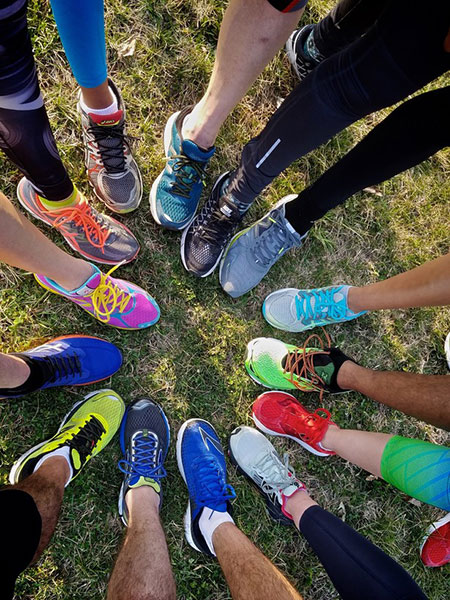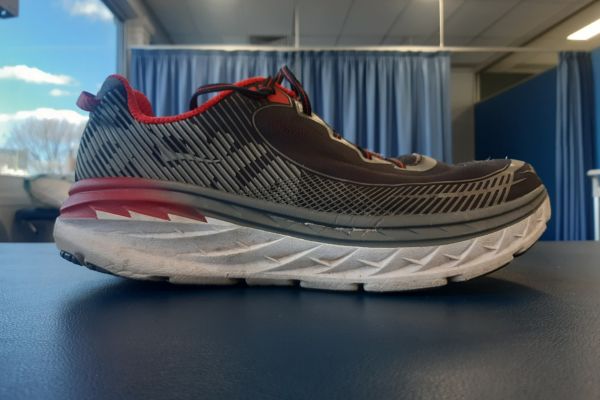What are the Best Running Shoes for Your Feet?
What are the best running shoes for your feet? In the last 15 years, there has been a huge increase in the variety of running shoes. However, with extra choice comes more decision making. How do you know which shoe is best for you? I’ll attempt to explain the different attributes of various running shoes, and how they affect your body.
Pronation control vs Neutral: Best Running Shoes – Do you pronate?
This is probably the most commonly discussed attribute of running shoes. For those that don’t know, pronation is the amount that your foot rolls inwards as you run or walk. So someone who pronates a lot tends to have flatter feet with lower arches. Conversely, neutral feet tend to have higher arches. But why is controlling pronation important?
For some runners, too much pronation can cause biomechanical issues. This can include sore feet, calves, knees, hips or lower back. Consequently, we often try to limit the amount of pronation someone has by changing to a shoe with more pronation control or orthotics, or both.
How Can a Running Shoe Control Pronation?
Pronation control comes in several forms depending on the shoe brand. The majority use a “medial dual density wedge” to slow pronation down. This is a more dense section of foam, usually from the heel to the arch, on the big toe side of the shoe. With the less dense foam on the pinky-toe side and more dense foam on the big-toe side of the shoe, your foot will hopefully pronate less. This can be more or less effective depending on how severe your pronation is and the shoe density.
You can test your running shoes by firmly pushing your thumb into the heel on both sides. If it is firm on the inside and soft on the outside; then your running shoes have some pronation control built into it.
Mizuno and Brooks running shoes solve the problem of pronation control slightly differently. Mizuno uses a thermoplastic that has more structure on the big toe side of the heel to stiffen this area. Brooks use what they call “Guide Rails” along the sides of the shoe where the sole meets the upper to attempt to hold the foot straight. In my experience, the Mizuno style support works well for severe over-pronators. Whereas, the Brooks type of support can be more comfortable for mild pronators. Ultimately it will depend on your foot shape and the fit of the shoe.
Heel Counter in Running Shoes
A heel counter is the stiff plastic section that wraps around your heel. Sometimes it is very obvious on the outside of the shoe. Sometimes it is hidden in the mesh. You’ll know if one is there by pushing into the back of the shoe and feeling how stiff it is.
Heel counters are generally a good attribute for pronation control as they provide stability through the back part of the shoe. Lots of neutral shoes also have a heel counter for some extra stability through the rear part of the shoe.
Generally I consider a heel counter a good attribute for most foot types. The only reason you may not like heel counters is if you have an extra bony heel where your achilles inserts such as a Haglunds deformity. In rare cases the extra stiffness can create an unwanted pressure area.
Heel Toe Drop Running Shoes
A VERY important shoe attribute rarely advertised or talked about. Heel toe drop refers to how high the heel part of the shoe is compared to the toe part of the shoe. For example a pair of thongs have same heel and toe height so would be a 0mm heel toe drop. A pair of high heels might have a 3 or 4cm heel toe drop.
Traditionally all runners used to have a 10mm heel toe drop. However, this has been tinkered with a lot in the last 15 years. There was a strong push towards “minimalist shoes” with less support and lower heel toe drop. This coincided with the barefoot or forefoot running trend. If you want to know more about the pros and cons of barefoot/forefoot running check out a review I did of the science behind it here.
What is the right heel toe drop for me?
The main things to take into account are your calf and achilles length, calf strength, and running style.
If you have tight calves, stiff ankles or a tight or sore achilles you will benefit from more heel toe drop. 10mm is generally as low as I would recommend. Same again if you are a bit weak in your calves or new to running. The increased heel toe drop will take some pressure off your calf and achilles.
If you are a strong forefoot striker and your heel rarely touches the ground when you run, you may be able to cope with a lower heel toe drop. Having said that, it is debateable whether going significantly lower is any better. Some of the worlds fastest road runners are breaking records in shoes with an 8mm heel to toe drop.
Rocker sole vs No Rocker Sole in Running Shoes
This refers to the shape of the sole of a shoe. Shoes with less rocker look relatively flat. More rocker and the shoe starts to be quite curved underneath.
The amount of rocker in the sole will change the feel of the shoe when you run. More rocker tends to put you on your toes earlier in the stride with less heel engagement with the ground. This has biomechanical implications as there will be slightly more calf and achilles effort if you are not used to running this way. If you are already a strong forefoot striker then you should cope with a rocker sole just fine. However if you are a heel striker then you may want to transition to a rocker sole slowly to avoid any calf or achilles injuries. Personally I find I’m happy running with a rocker sole with short fast runs such as interval efforts, but happier with a regular sole for my longer slower runs.
Some Simple In-store Running Shoe Tests You Can Do
- Firstly, check the above points:
- Do you need pronation control?
- Do you need a heel counter?
- How much heel toe drop are you after?
- How much rocker do you want?
- What is the overall structure of the shoe like?
- Grab the toe of the shoe in one hand and heel in the other and try to firmly flex the shoe. It should preferably flex through the toes and forefoot but not too much through the arch.
- Now try to twist the toe and heel in opposite directions. Most of the movement should occur in the front of the shoe with less through the middle and rear part of the shoe.
- Does the shoe fit?
-
- Is it comfortable? Clearly, you will not run for long if it isn’t!
- Is it the correct length and width? Most people know their shoe size (length) but aren’t sure about their shoe width. A great way to check if a shoe is the correct width for you is to take the inner sole out and stand on it. Ideally your whole foot should just fit on the inner sole with not too much room to spare. If your foot is too wide for the inner sole the shoe will not provide you the correct support as you’ll tend to fall off the shoe. You may even lose some extra toenails due to them jamming in the shoe. If your foot is too narrow for the inner sole you may slide around inside the shoe and get blisters.
To compare all these attributes there is a good website called Run Repeat.
Please note we have no associations with any running shoe brands. All photos were purely to demonstrate concepts and are not indicative of all shoes in each brand’s range.


 Less rocker
Less rocker